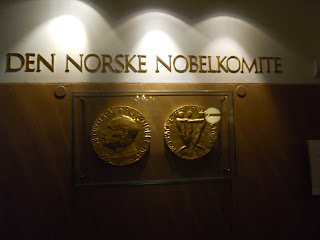 |
| The Nobel Institute's Medal |
Sitting once more amid the perfume-scented lounge, sipping tea (which, loaded with sugar, I have recently come to enjoy), my mind turns to academics. While I am experiencing the culture of Norway and melding my own experiences with the lives of others at the International Summer School, I am also here to learn.
Because of that, I'm taking two courses. The first is Norwegian history, and the second is a small seminar on peace. Both courses have been incredibly thought-provoking and powerful thus far. In explanation, I will start with Norwegian history.
As primarily a French historian, I have not devoted much time to the Nordic countries. Of course, the expeditions and raids of the Vikings are well known to me, but, obviously, there is much more to learn. This past week, we have delved into the sagas and mythology of Viking-era Scandinavia. It really is interesting to note connections between the Greek and Norse pantheon. For instance, one source mentioned that the Norse gods were sons of Priam from Troy and traveled north to come to Norway. Furthermore, Zeus is often depicted as an old man, full of rage and often in disguise. Likewise, the Norse god Odin is old, bearded, and often disguised. This is done in order to instill the notion of hospitality into society; if the god can be disguised as a beggar, it is better not to refuse hospitality or care to anyone for fear it could be a god. Next, we will enter the later Midieval world. Eventually, we will come to the union of Norway with Denmark. However, the Napoleonic scholar in me is incredibly interested in what follows that: the failed attempt by Norway to escape Swedish dominance under the hated French traitor Jean Baptiste Bernadotte- or King Karl Johann to the Swedes. As you can see, there is much to learn amid the fjords of Norge.
My next course of study is a seminar on peace. This is conducted with the ten peace scholars and includes frequent excursions into the city to visit museums and other important centers for peace. We have lecture once a week, and while the reading is very intensive, it provides for powerful discussion. What are the best ways to establish lasting peace? It is a very difficult to answer, and the answers themselves are highly varied. Perhaps I will know more by the end of all of this. Our weekly excursion was actually split into two trips this week. The first day we went to the Nobel Institute. We stood amidst the room where the prize's recipient is determined. The faces of great men and women stared around us as we looked as each winner's portrait. Next, we entered the reception hall where the winner is announced; the entire trip was quite powerful.
The next day, we again took to the metro to study peace. Our destination this time was the Nobel Peace Center. This museum functions as an introduction to the work of the Nobel Institute and also presents various displays on current world conflicts and peace issues. On display was a wonderful photographic collection from modern conflicts around the world. The sufferings in Bangladesh, Yemen, Syria, Iraq, Afghanistan, and even Norway were offered to us through incredibly poignant images. Additionally, a collection on Nansen was also shown. It was very fun to see our old friend in Oslo once more.
 |
| The Faces of the Laureates |
No comments:
Post a Comment